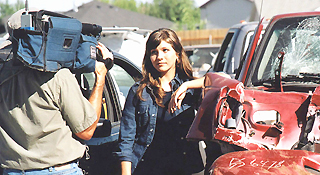
|
CONNECTIONS
|
IDAHO
ITD
HOME
IDAHO DMV
ITD NEWS
HIGHWAY
SAFETY
IDAHO STATE
POLICE
TRAVEL SERVICES
STATE OF IDAHO
NATIONAL
AASHTO
AAMVA
AAA of IDAHO
FEDERAL HIGHWAYS
FEDERAL AVIATION
IDAHO STATE POLICE
NHTSA
NTSB
TRB
U.S. DOT
Idaho
Transportation
Department
Public Affairs Office
P.O. Box 7129
Boise, ID 83707
208.334.8005
Fax: 208.334.8563
Email

Seat
belt video strives for high impact among teens
Teens have a higher fatality rate in motor vehicle crashes than any other age group largely because they have lower safety belt use rates than adults, according to the National Highway Traffic Safety Administration.
“In Idaho, drivers between the ages of 15 and 19 account for one out of every four crashes,” said Josephine O’Connor, ITD Office of Traffic and Highway Safety.
 “The
sad thing is, many fatalities and injuries associated with those crashes
could have been prevented if only (teens) had worn their seat belts.”
“The
sad thing is, many fatalities and injuries associated with those crashes
could have been prevented if only (teens) had worn their seat belts.”
In an effort to change attitudes that may keep teens from buckling up, the OTHS will sponsor multimedia presentations in junior high and high schools this fall. The presentations are projected onto 10-foot screens and incorporate loud music and fast-paced images. Teens are encouraged to make good choices, including wearing seat belts and not drinking and driving.
Famous faces, from rock stars to football players, share
personal stories about poor choices that affected their lives.
A 10-minute video chronicling the story of the Root family is an integral
part of the multimedia presentation. Four members of the family were
on a trip when they experienced firsthand the value of wearing seat
belts. Daughter Jennifer was at the wheel. As she attempted to pass
another vehicle on a two-lane highway, she felt the steering wheel begin
to shake. Within seconds she lost complete control of the vehicle. The
car rolled 3-1/2 times before coming to a stop.
In the video, Jennifer, now 16, urges other teens to buckle up, even if it’s “not the thing to do” or isn’t cool. A dancer, she tells viewers that she wouldn’t be able to perform with her dance team had she been without the seat belt at the time of the crash.
Misty Taylor, former Miss Idaho, is the video’s narrator and on-camera host. She talks about seat belt use as she wanders through an auto salvage yard.
“Seat belts don’t mess up your hair, wrinkle
your clothes or restrict your breathing, but they can save your life,”
Taylor says amid a collection of totaled cars and trucks. “But
seat belts need to be fastened before you need them.
“There’s nothing cool about not wearing a seat belt. Don’t
be embarrassed to tell your friends and family to get buckled.”
Failure to buckle up isn’t the only factor putting teens at risk for higher fatality rates in crashes. Many teens frequently engage in high-risk behaviors, such as speeding and/or driving after using alcohol or drugs, while still learning the new skills needed for driving.
Studies also show that teens may be easily distracted while driving, according to NHTSA.
America’s youth population has increased by more than 12 percent since 1993 and is expected to increase by another seven percent by 2005.
|
Teens at Risk
|